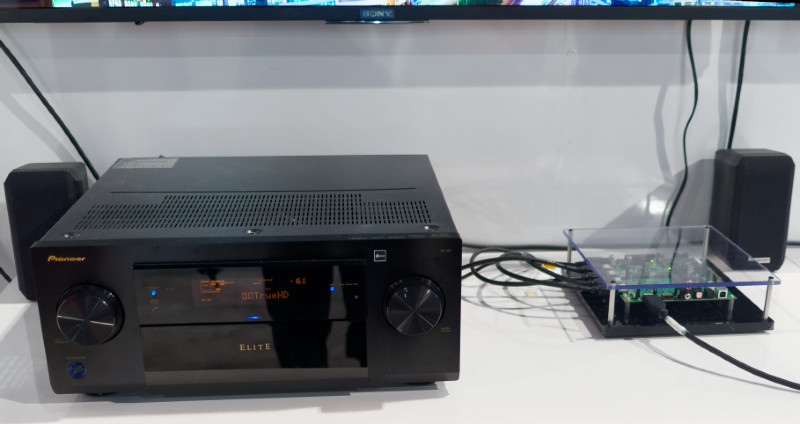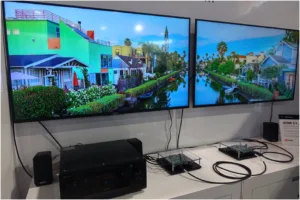At the end of 2017, HDMI Licensing released the final specification for the next generation interface: HDMI 2.1. (HDMI 2.1 Finalised – Support for 4K120 and 10K) This will involve a massive change in the signaling and data rates, but will retain the same connector and pin-outs. At CES 2018, the organization hosted a booth to talk about the features of HDMI 2.1 and to showcase the first transceivers.
On display in the booth was an HDMI 2.1 prototype transceiver pair from Invecas. With up to 48 Gps capable over four lanes, 8K/120p can even be supported with Display Stream Compression (DSC). However, instead of showing an 8K distribution demo, Invecas decided to show distribution of two 4K signals over a single HDMI 2.1 interface.
To do so, it used a PC to generate two 4K video streams over HDMI 2.0 lines, which were merged into a single stream and sent to the prototype HDMI 2.1 transmitter. A 2.1 receiver decoded and un-merged the signal, sending them to two 4K 55” Sony TVs (via HDMI 2.0) to prove the transmission worked.
Commercialization of HDMI 2.1 transceivers is not expected until the second half of 2018, with TV and related products adopting it in 2019. That’s because the test specification still needs to be developed and approved before certification testing can begin. The test spec isn’t expected until late spring or early summer.
HDMI Specification 2.1 feature highlights include:
- Higher video resolutions support a range of high resolutions and faster refresh rates including 8K60Hz and 4K120Hz. Resolutions up to 10K are also supported for commercial AV, and industrial and specialty usages.
- Dynamic HDR on a scene-by-scene or even a frame-by-frame basis.
- The Ultra High Speed HDMI Cable supports the 48G bandwidth for uncompressed HDMI 2.1 feature support. The cable also features very low EMI emission and is backwards compatible with earlier versions of the HDMI Specification and can be used with existing HDMI devices.
- eARC simplifies connectivity, provides greater ease of use, and supports the most advanced audio formats and highest audio quality. It ensures full compatibility between audio devices and upcoming HDMI 2.1 products.
- Enhanced refresh rate features ensure an added level of smooth and seamless motion and transitions for gaming, movies and video. They include:
- Variable Refresh Rate (VRR) reduces or eliminates lag, stutter and frame tearing for more fluid and better detailed gameplay.
- Quick Media Switching (QMS) for movies and video eliminates the delay that can result in blank screens before content is displayed.
- Quick Frame Transport (QFT) reduces latency for smoother no-lag gaming, and real-time interactive virtual reality.
- Auto Low Latency Mode (ALLM) allows the ideal latency setting to automatically be set allowing for smooth, lag-free and uninterrupted viewing and interactivity.
The group was highlighting the latest Premium High Speed HDMI cables which are starting to gain traction in the market and are being promoted – the company showed us that the Roku Ultra now has a recommendation of the cable on its packaging.
One of the big developments in HDMI is eARC, which is critical in allowing receiver makers to support developments in HDMI audio without having to re-design their receivers. We covered this in the newsletter last month, so won’t repeat it here. (HDMI 2.1 Enhanced Audio Return Channel (eARC) is a Future-Proof Solution However, at the show, we heard that a number of receiver makers have built the technology into their latest shipping products and are now just waiting to complete testing before announcing that their products support the technology. Simplay was on the HDMI booth and showing how it could test for eARC compliance.
On the booth there was a modified Panasonic UltraHD Blu-ray player that supports eArc.
 HDMI had an eArc demo using a Panasonic BD Player, with a Sony TV and Pioneer receiver. Image:Meko
HDMI had an eArc demo using a Panasonic BD Player, with a Sony TV and Pioneer receiver. Image:Meko
Teledyne LeCroy was also on the booth showing its latest testers for HDMI 2.1.
Analyst Comment
Our usual pattern in checking HDMI was changed this time as Invecas bought the HDMI chip business from Lattice, which had itself acquired Silicon Vision. Invecas also bought a division of Simplay. (That meant that our visit to Lattice was much shorter and really only covered eArc.) (BR)

